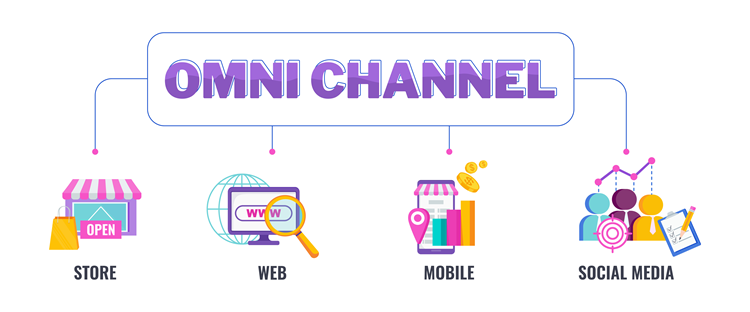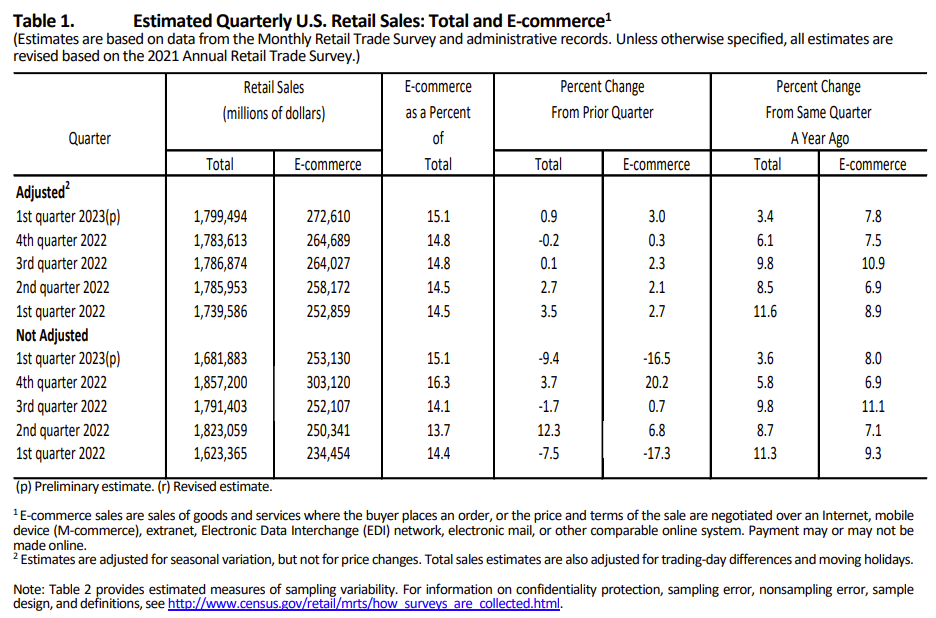Introduction to the four-part series on eCommerce businesses.
The eCommerce industry experienced a steady growth rate pre-pandemic. The industry then saw an unprecedented surge during the pandemic. The pandemic changed online shopping from an option to a necessity. Post-pandemic, eCommerce businesses are seeing a decline in sales. At the same time, in-store sales in the US have been increasing. In this blog post, we will be discussing the trends for small business to mid-market businesses that will shape the future of eCommerce. From customer retention and fulfillment to compliance and risk management followed by revenue growth and operational scaling, competition, and online presence. What is next for eCommerce?
Make or Break the eCommerce Business
Your eCommerce success hinges on multiple factors. To succeed in this highly competitive industry, businesses must cater to their target market through SEO and social media marketing strategies. A business model that incorporates subscriptions or exceptional customer service can also boost loyalty and retention rates. Ecommerce store owners must prioritize logistics, shipping, packaging, and delivery times to ensure customer satisfaction. By leveraging analytics and integrating with applicable tools like Google or Meta, eCommerce store owners can continue to stay ahead of the curve.
The Current State of eCommerce
Some salaries are on the rise, with a record low in unemployment rates. However, inflation has reached its peak. Business expenses such as shipping, fulfillment, and labor costs, as well as customer acquisition costs, for eCommerce companies, have all increased. As a result, digital prices (digital pricing is model-based, data-driven, and adaptive, connecting price to value across the customer journey, def) have risen but not to the same extent as retail prices. Consumer confidence is dwindling, leading to decreased spending compared to last year. The percentage of eCommerce sales out of total retail sales is approaching pre-pandemic levels. With intense competition for consumer spending, it is crucial to focus on creating an excellent user experience that captures shoppers’ attention and motivates them to make purchases.

Advantages and Disadvantages of eCommerce
The benefit of an eCommerce business is that online stores allow for a bigger reach and audience. This expands the market potential and increases the opportunities for growth. Ecommerce eliminates the need for a physical storefront, which significantly reduces overhead costs such as rent, utilities, and maintenance. Additionally, online marketing and advertising are often more cost-effective than traditional methods. Ecommerce platforms are highly flexible, allowing businesses to adapt quickly to changing market conditions, customer preferences, and industry trends.
One of the major disadvantages of eCommerce is the loss of face-to-face interaction between customers and the products. Customers cannot physically inspect products before purchasing, which may lead to dissatisfaction if the product does not meet their expectations. Additionally, the loss of personal interaction may limit the ability to ask questions or seek clarification, leading to potential miscommunication. Another disadvantage may be that online transactions involve sharing personal and financial information, which may increase cyber threats such as hacking, data breaches, or identity theft.
Customer Retention and Fulfillment
What can a business do to retain its customer base? Some options are live chat, loyalty programs, subscription services, reviews, and personalization. Additionally, order management plays a crucial role in customer satisfaction. When customers place an order with a business, they have certain expectations regarding the product or service they are purchasing.
Live Chat
Live chat is becoming an increasingly popular way for eCommerce businesses to provide customer support and improve customer retention rates. Customers can receive quick and personalized responses to their inquiries or issues through live chat in real time. Additionally, it allows ecommerce businesses to gather feedback from their potential customers and address any concerns or complaints efficiently. By using live chat as a tool for providing excellent customer service, eCommerce companies can build trust and loyalty among their target audience. This results in increased revenue generation by gaining loyal customers who shop frequently from the online store.

Do Loyalty Programs Work?
Implementing a loyalty program in e-commerce may improve customer retention, engagement, satisfaction, and business growth, as well as provide useful data and insights for marketing and product development. Personalized rewards like exclusive access or discounts can enhance the effectiveness of a loyalty program. However, the success of the program depends on its execution.
Add Subscriptions to Product Offering
Subscription programs implemented by eCommerce businesses can provide their customers with a convenient and predictable shopping experience, as well as provide businesses with a more predictable revenue stream. By providing a unique subscription model or exclusive benefits, companies can attract customers who value the convenience, personalized experience, and ongoing relationship that subscriptions offer. Some service providers for subscriptions are Ordergroove and Rebillia.
By utilizing subscription services, eCommerce businesses can establish themselves as niche providers within their target market and differentiate themselves from competitors such as Amazon or eBay. Additionally, offering subscriptions can aid in the collection of valuable data regarding customer preferences which can inform marketing strategies.
Capture and Show Reviews
To build trust and credibility with potential buyers, eCommerce businesses should prioritize capturing customer feedback. Displaying positive reviews on their website or social media platforms can help attract new customers. Additionally, using surveys or follow-up emails to capture customer feedback can help in improving the business and its products. By actively seeking out and utilizing customer feedback, eCommerce businesses can effectively establish themselves as reliable sources for their target audience.
Personalization Leads to Retention
To provide exceptional customer experiences, drive sales, foster customer loyalty, and remain competitive in an increasingly digital marketplace, personalization in sales is crucial for eCommerce companies. Personalization can provide an enhanced customer experience, increased conversion rate, higher average order value, and improved customer retention. Additionally, by gathering and analyzing data related to customer behavior, preferences, and purchase history, eCommerce companies can gain valuable insights into customer trends, market demands, and product performance.
Inventory Management
Order management refers to the process of efficiently handling and fulfilling customer orders from the initial placement to the final delivery. It involves various activities such as order processing, inventory management, shipping, and tracking. Effective order management ensures that customer orders are accurately and promptly fulfilled, leading to customer satisfaction and ultimately contributing to customer retention. By meeting and exceeding customer expectations throughout the order process, businesses can foster long-term customer loyalty and retention.

Compliance and Risk Management
For eCommerce businesses looking to succeed in today’s ever-changing landscape, compliance and risk management are crucial considerations. Adapting to changing regulations related to taxation, data protection, consumer rights, and cross-border transactions can pose challenges. Staying ahead of the game means implementing robust security measures against potential fraud or cyberattacks. Ensuring the safety of customer information is paramount; offering secure payment options such as two-factor authentication or encryption can go a long way towards earning customer trust.
ADA Compliance
Ensuring your eCommerce website is ADA compliant is vital in making it accessible to users with disabilities. To comply with regulations and improve the user experience of your online store, companies can hire developers to program their eCommerce store per the Web Content Accessibility Guidelines (WCAG. Other alternatives include utilizing the services of companies such as accessiBe. Adding alt text to images, providing captions for videos, and maintaining proper color contrast are some ways you can achieve compliance and make your website accessible for everyone. Not only does this help you avoid legal action, but it also enhances your customer’s shopping experience.
eCommerce Store Uptime
Maintaining uptime for an ecommerce business is vital as downtime leads to loss of sales & customer trust. Backup & restore security measures by companies like Rewind help achieve that. You can’t afford for your store to go down. SaaS platforms such as BigCommerce make it their highest priority to make sure it doesn’t. With industry-leading uptime at 99.99%, BigCommerce keeps your commerce engine running, giving you the competitive edge.
Manage Cyber Threats
With the rising frequency and sophistication of cyber threats, eCommerce companies need to prioritize cybersecurity to protect customer data, financial transactions, and sensitive information. Ensuring robust security measures and maintaining customer trust is crucial. As data breaches become more common, concerns about privacy and data protection have grown. eCommerce companies must comply with relevant data protection laws and regulations and implement measures to safeguard customer data, ensuring transparent data practices and obtaining appropriate consent. Using SaaS platforms like BigCommerce help as they maintain servers, install updates or patch the servers when security vulnerabilities are discovered.

What is Fraud and How to Avoid It
Protecting your eCommerce business from fraud is crucial for its success. Illegal activities involving deception or misrepresentation for financial gain can cause significant financial losses. Ecommerce stores are especially vulnerable to fraudulent activities because of the anonymity that online transactions provide. Incorporating security measures such as two-factor authentication and encryption help mitigate the risk of fraud. It’s essential to stay up to date on current trends and adjust business practices accordingly to avoid potential harm from fraudulent activities. Taking proactive steps like these will help protect the reputation and bottom line of any eCommerce store owner.
Revenue Growth and Operational Scaling
Maximizing revenue growth is an ongoing process that requires continuous monitoring, adaptation, and experimentation. To maximize revenue and ensure operational scalability, companies must implement key strategies and practices. Choose an eCommerce platform and software architecture that can handle high volumes of traffic and transactions. Automate certain aspects of your business, outsource or partner with third-party logistics providers, or explore new sales channels like Amazon and social media platforms to help streamline your operations. Additionally, leverage analytics to uncover insights about your target audience and their shopping habits to make more informed decisions and drive growth for your business.
Multi-Channel vs. Cross-Channel vs. Omnichannel: What Marketing Strategy to Choose?
When it comes to marketing, there are different approaches to consider based on your business goals and target audience. Multi-channel uses various platforms to reach customers and each channel operates independently. There might not be much integration or synchronization between them.
Cross-channel creates a consistent experience. Cross-channel strategies focus on creating a consistent brand message and experience across multiple touchpoints.
Omnichannel integrates all channels for a personalized strategy favored by many due to its higher conversion rates. In an omnichannel strategy, channels are connected and synchronized, allowing customers to switch between them without disruption. For example, a customer can start researching a product on a website, continue on a mobile app, and complete the purchase in a physical store, with all information and preferences seamlessly transferred.

Using Analytics to Uncover Insights
Analytics can be immensely useful for eCommerce companies in various ways. By analyzing customer, product, and operational data, you can make informed decisions that lead to better business outcomes. Use customer data to gain deep insights into a customer’s behavior, preferences, and purchasing patterns. Additionally, product data enables you to identify emerging trends and optimize your product offerings accordingly. Analytics plays a crucial role in powering personalized experiences for customers. By leveraging data on customer preferences, purchase history, and browsing behavior, eCommerce companies can create recommendation engines that suggest relevant products or personalized offers.
Leverage AI To Improve Lead Generation
To enhance your eCommerce business’s lead generation potential, consider leveraging artificial intelligence (AI). AI can analyze vast amounts of data to identify patterns and trends, enabling ecommerce companies to predict customer behavior, preferences, and purchasing patterns. Use this information to target potential leads more effectively. In addition, AI algorithms can recommend relevant products and tailor marketing messages to individual customers, increasing the chances of generating leads.
Integrating Your ERP With Your eCommerce Platform
Integrating your ERP system with your eCommerce platform is crucial in optimizing your online store’s efficiency. With real-time inventory management and order tracking, you reduce the risk of overselling or stockouts that could negatively affect potential customers’ shopping experience. This automation also saves valuable time and reduces costs, allowing you to focus on growing your business by targeting your niche audience using SEO strategies or leveraging social media marketing tactics. By integrating your ERP system with an eCommerce platform like BigCommerce using a company like Jitterbit, you are one step ahead of the competition and can make data-driven decisions that drive growth while ensuring a seamless user experience.
Growing With Your eCommerce Platform
To ensure your choice of eCommerce platform can scale as your operations grow, look for these deciding factors. Assess whether the platform can handle increased traffic, sales volume, and product offerings as your business grows. Ensure that the platform can deliver fast and reliable performance, as slow loading times or frequent downtime can significantly impact user experience and sales. Make sure the platform supports the integration of your needed services such as payment gateway, inventory management systems, marketing tools, etc. Verify that the platform adheres to industry-standard security practices. Finally, assess the platform’s ability to accommodate future expansion plans and the availability of upgrade paths or higher-tier plans with advanced features.
Competition and eCommerce Presence
In today’s ecommerce business landscape, staying ahead of the competition is crucial. One way to achieve this is by building a strong online presence that resonates with potential customers. Conduct market research to get insights into what your competitors are doing and optimize your website for search engine visibility. Identify your target audience, create unique content, and drive traffic from social media platforms such as Instagram or Facebook. Always keep user experience in mind while designing for conversion through effective call-to-actions or shopping cart optimization.
Do a Competitive Analysis
To have an edge over the competition while running an eCommerce business, always research competitors to identify them and analyze their online presence alongside product offerings, pricing strategies and customer reviews. Use this information to differentiate your business from others in the niche and improve your eCommerce strategy. To stay ahead of the pack in the ever-evolving ecommerce market; keep yourself updated with the latest industry trends.
Know your Target Audience
To succeed in your eCommerce business, it’s crucial to know your target audience. By understanding their needs and preferences, you can tailor your marketing strategies and product offerings for maximal effect. Customer surveys, website analytics, and social media monitoring are great ways to gather invaluable insights into your target market. Finally, having a frictionless eCommerce store that offers a smooth shopping experience along with smart marketing strategies is vital for attracting new customers.
Design for Conversion
To enhance the potential of an online store of an eCommerce business, it is imperative to prioritize designing for conversion. In contrast to brick-and-mortar stores, eCommerce businesses have limited opportunities for shoppers to establish a connection with their products or services. Therefore, investing in user experience (UX) and customer journey mapping are vital components of designing an appealing eCommerce website. UX focuses on enhancing the overall experience of users while they interact with an eCommerce website or mobile app. The goal is to make the shopping process seamless, intuitive, and enjoyable, leading to increased customer satisfaction and conversions.

Create Unique Content
Creating unique content is vital for the success of any eCommerce business. Google values unique and original content because it provides value to users. By creating high-quality and relevant content, you can optimize your product pages, category descriptions, and blog posts with keywords and information that align with user intent. This helps search engines understand your content better, leading to higher rankings in relevant search results. By offering informative and engaging product descriptions, detailed specifications, and unique features, you can persuade potential customers to choose your store over competitors. This improved user experience can result in increased time spent on your site, lower bounce rates, and higher conversion rates—all of which positively influence Google rankings.
Driving Traffic from Social
Social media is increasingly becoming an essential channel for driving traffic and sales for eCommerce websites. To succeed in this area of business, it is vital for online store owners to have a strong presence on platforms that align with their target audience. Common platforms for eCommerce include Facebook, Instagram, Twitter, LinkedIn, TikTok and YouTube. Each platform has its own strengths, so choose the ones that best suit your business and goals. Take advantage of social commerce features provided by platforms like Facebook Shops. These features enable users to browse and purchase products directly within the social media platform, streamlining the buying process.
Future of eCommerce
As the world becomes more connected and digital, eCommerce continues to grow at an unprecedented rate. Changing consumer behavior is a key factor driving the growth of eCommerce. With the increasing use of technology and social media, consumers are becoming more comfortable with making purchases online. Additionally, younger generations are more likely to prefer online shopping through Instagram’s Checkout and Facebook’s Marketplace, for example, to traditional brick-and-mortar stores. As these trends continue, eCommerce will become an even more important part of the retail landscape.
Leverage eCommerce Toolset
Managing a successful eCommerce business requires using all available tools. This toolset includes the use of social commerce and other marketplaces (omnichannel); using data analytics and AI to provide customized product recommendations, targeted advertising, and personalized email marketing; offering subscription services; and the research and understanding of competitors and customer segments. Retailers who stay ahead of these trends and provide exceptional customer experiences will be well-positioned for success in the years to come.

Conclusion
The eCommerce industry has transformed into an integral part of our daily lives. Each year, new trends emerge, leading to continuous evolution within the industry. With numerous eCommerce players in the market, business owners must elevate their game to stay competitive. The highly saturated eCommerce industry necessitates that brands provide superior shopping experiences if they want to stand out amongst a sea of similar competing products. In addition to offering quality products and services, businesses need to focus on building strong customer relationships by providing efficient delivery options, simplified checkout processes, and personalized recommendations based on user data. By prioritizing customer satisfaction and continuously adapting to changing trends, businesses can thrive in the ever-evolving world of eCommerce.
Other Articles You May Be Interested In
